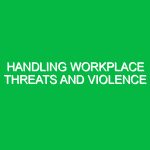In today’s rapidly evolving world, security awareness in the workplace has become a paramount concern for organizations across various sectors. This concept transcends the mere idea of protecting physical assets; it encompasses safeguarding employees, information, and the environment. In the Health, Safety, and Environment (HSE) domain, security awareness plays a crucial role in creating a safe and productive workplace. This article delves into the intricacies of security awareness, identifies potential hazards, outlines safety precautions, and highlights relevant regulations.
What is Security Awareness in the Workplace?
Security awareness in the workplace refers to the understanding and recognition of various security threats that could affect an organization’s operations. It involves educating employees about potential risks, protective measures, and best practices to mitigate those risks. This awareness is essential not only for protecting tangible assets like equipment and data but also for ensuring the safety and well-being of employees. In the HSE context, security awareness integrates occupational safety and health with environmental concerns, fostering a holistic approach to safety management.
The Relevance of Security Awareness in HSE
In the realm of Health, Safety, and Environment, security awareness is vital for several reasons:
- Employee Safety: A well-informed workforce is better equipped to recognize threats, whether they stem from workplace violence, natural disasters, or hazardous materials.
- Operational Continuity: Understanding security protocols helps maintain business operations during emergencies, minimizing downtime and loss.
- Regulatory Compliance: Many industries face stringent regulations regarding workplace safety and environmental protection. Awareness ensures adherence to these regulations.
- Reputation Management: Organizations that prioritize security awareness cultivate trust among clients, stakeholders, and the community, enhancing their reputation.
Identifying Potential Hazards and Risks
Understanding potential hazards is the first step toward effective security awareness in the workplace. These hazards can be categorized into several types:
1. Physical Hazards
Physical hazards include risks associated with the physical environment. For instance, inadequate lighting can lead to accidents, while poorly maintained equipment poses operational risks. A personal experience comes to mind: while working in a manufacturing setting, I witnessed a colleague trip over a poorly marked step, resulting in a sprained ankle. This incident underscored the need for proper maintenance and clear signage.
2. Chemical Hazards
Chemical hazards arise from the use of hazardous substances in the workplace. Employees must be aware of the materials they handle, including proper storage, usage, and disposal procedures. For example, a chemical spill in a laboratory due to negligence can lead to severe health risks and environmental damage. Regular training on Material Safety Data Sheets (MSDS) is essential to inform employees about the hazards associated with chemicals they work with.
3. Biological Hazards
Biological hazards refer to exposure to harmful microorganisms, including bacteria, viruses, and fungi. In healthcare settings, for example, the risk of infection from contaminated surfaces or equipment is significant. A case in point is the COVID-19 pandemic, which highlighted the necessity for stringent hygiene practices and awareness of infectious disease transmission. Organizations must implement training on infection control and personal protective equipment (PPE) use to mitigate these risks.
4. Ergonomic Hazards
Ergonomic hazards stem from workplace design that does not accommodate employee needs, leading to musculoskeletal disorders. In an office environment, poor seating arrangements and improper desk setups can result in chronic pain and discomfort. To combat this, organizations should conduct ergonomic assessments and provide adjustable furniture to enhance employee comfort and productivity.
5. Psychosocial Hazards
Psychosocial hazards involve risks related to the work environment and organizational culture, including workplace bullying, stress, and fatigue. The impact of these hazards is often underestimated. For instance, a colleague once shared how workplace stress led to burnout, affecting both performance and mental health. Organizations must foster a supportive work environment, promoting open communication and mental health resources.
Safety Precautions and Best Practices
Once potential hazards are identified, implementing safety precautions becomes imperative. Here are several actionable measures that organizations can adopt:
1. Conduct Regular Training
Training sessions should be an ongoing process, not a one-time event. Employees must be regularly updated about new risks, safety protocols, and emergency procedures. Interactive training methods, such as simulations and role-playing, can enhance engagement and retention of information. For instance, a construction company I worked with conducted quarterly safety drills that significantly improved employees’ response to emergencies.
2. Develop Comprehensive Safety Policies
Organizations should establish clear safety policies that outline protocols for various scenarios, including emergency evacuations, reporting hazards, and using PPE. These policies should be easily accessible and communicated to all employees. Regular reviews of these policies ensure they remain relevant and effective as the workplace evolves.
3. Foster a Safety Culture
Creating a culture of safety involves encouraging employees to prioritize safety in their daily tasks. This can be achieved by recognizing and rewarding safe behaviors, promoting teamwork, and encouraging employees to report hazards without fear of retribution. A culture that values safety leads to increased vigilance and proactive behavior among employees.
4. Utilize Technology for Enhanced Security
Modern technology can play a significant role in enhancing workplace security. For instance, surveillance systems can monitor premises, while access control systems ensure that only authorized personnel enter sensitive areas. Moreover, data protection measures, such as encryption and multi-factor authentication, safeguard sensitive information against cyber threats. Organizations should invest in the latest security technologies to mitigate risks effectively.
5. Conduct Risk Assessments
Regular risk assessments help organizations identify new and existing hazards. These assessments should be comprehensive, considering all aspects of the workplace, from physical conditions to employee well-being. Engaging employees in the assessment process not only provides diverse perspectives but also fosters a sense of ownership toward workplace safety.
Regulations and Standards Governing Security Awareness
Numerous regulations and standards govern security awareness in the workplace, ensuring organizations prioritize safety. Some notable ones include:
1. Occupational Safety and Health Administration (OSHA)
In the United States, OSHA establishes and enforces safety standards for workplaces, covering various aspects including employee training, hazard communication, and emergency preparedness. Compliance with OSHA regulations is crucial for organizations to avoid penalties and ensure a safe working environment.
2. ISO 45001
This international standard for occupational health and safety management systems provides a framework for organizations to improve employee safety, reduce workplace risks, and create better working conditions. Implementing ISO 45001 can enhance an organization’s safety culture and demonstrate a commitment to employee well-being.
3. Environmental Protection Agency (EPA)
The EPA regulates environmental hazards and enforces laws to protect air and water quality. Organizations must comply with regulations regarding hazardous waste disposal and emissions, ensuring that their operations do not harm the environment or public health.
4. Local Regulations
Many regions have specific regulations regarding workplace safety and environmental protection. Organizations should familiarize themselves with local laws to ensure compliance and avoid legal ramifications. Regular consultations with legal experts can ensure that an organization’s practices align with current regulations.
Conclusion
In conclusion, security awareness in the workplace is a multifaceted approach that is vital for maintaining a safe and productive environment. By recognizing potential hazards, implementing safety precautions, and adhering to relevant regulations, organizations can foster a culture of safety that protects employees and the environment. As the world continues to change, prioritizing security awareness will equip organizations to navigate challenges effectively, ensuring their resilience and success in the long run.


